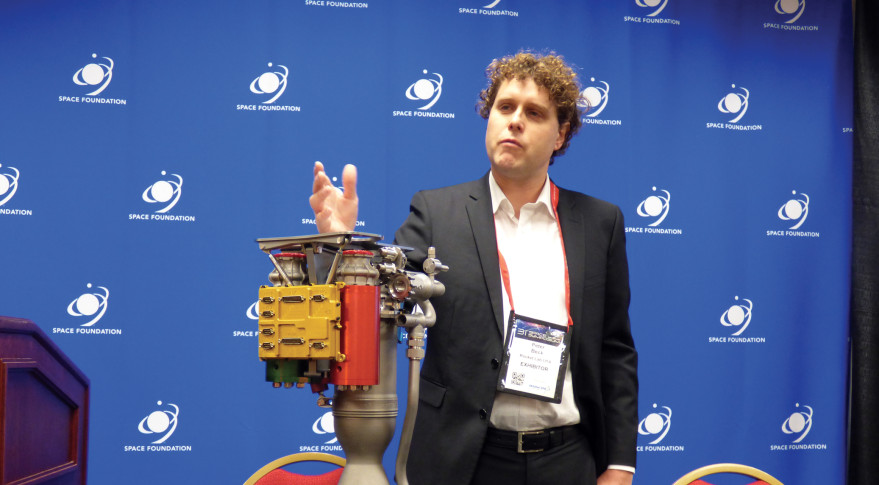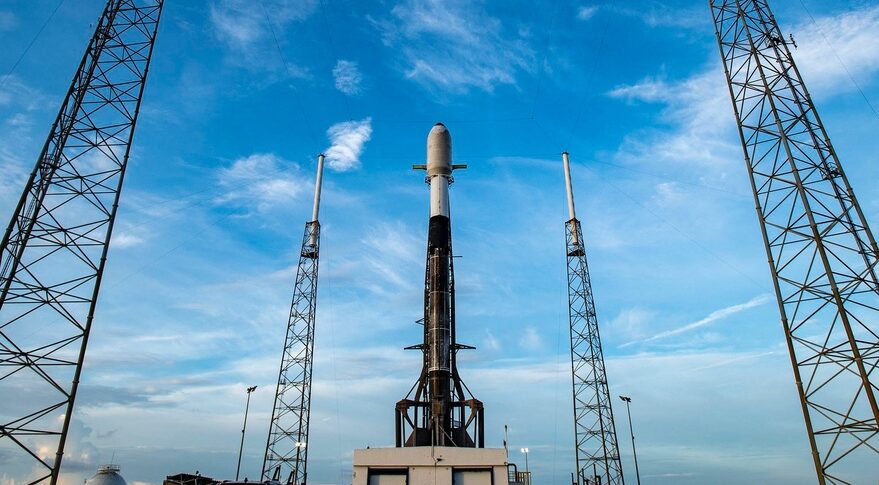Rocket Lab Unveils Battery-Powered, 3-D-Printed Rocket Engine
COLORADO SPRINGS, Colo. — A U.S.-New Zealand company developing a small satellite launch vehicle said April 14 that it has completed development of the rocket’s main engine, one that makes use of advanced technologies to reduce costs.
Rocket Lab Ltd. said at a press conference during the 31st Space Symposium here that it has wrapped up work on the Rutherford engine that will power its Electron small launch vehicle, designed to launch once per week for less than $5 million per flight.
“If we’re serious about commercializing space and making a big difference in space,” Rocket Lab Chief Executive Peter Beck said, “we need to reduce the launch cost and increase the launch frequency.”
Rutherford makes use of several advanced technologies to improve its performance and lower its cost. Instead of a conventional turbopump that runs on a gas generator, the engine’s pump is powered by a battery that Beck says is far less complex.
In an earlier interview, Beck said they elected to use a battery because it offered the best opportunity to reduce costs. “Unless you solve the turbopump problem, it’s really difficult to build a cost-effective system,” he said.
The battery-powered pump, he said, can be easily changed with software, making it far easier to modify. “It takes a really complex thermodynamic problem and turns it into software that’s infinitely tweakable,” he said
Rocket Lab is also using additive manufacturing, or 3-D printing, to produce the engine. Beck said that the use of 3-D printing allows the company to produce components that would be difficult or impossible to fabricate with conventional approaches, and also allows the parts to be produced more quickly.
“We adopted and embraced that technology because it provides us with the ability to produce engines and components at a cost and a frequency that traditional manufacturing techniques can’t achieve,” Beck said. Additive manufacturing allows the company to build a rocket engine in three days, versus a month for traditional approaches.

To avoid complications with payload processing, Beck said Rocket Lab plans a containerized approach, where customers package their satellites in payload fairings provided by the company, which can be stored and easily attached to the rocket when it’s time to launch. “We can integrate them within literally minutes,” he said. “It’s four bolts and we have a payload completely integrated onto the launch vehicle.”
Those innovations, he said, are essential to the company’s plans for low-cost and frequent launch services. “All the innovations around Rutherford are not innovations because they’re cool, they’re innovations to solve a problem.”
With Rutherford complete, Rocket Lab is preparing for a first launch of Electron by the end of this year. The vehicle, which uses nine Rutherford engines in its first stage and one in its second, is designed to place payloads of up to 100 kilograms into orbit at a price of $4.9 million.
The company ultimately plans to perform weekly launches of Electron from a private launch site in New Zealand. Beck said the company plans to perform three Electron test launches, starting late this year, and then perform monthly launches for the first year of operations before eventually ramping up to weekly launches.
The New Zealand launch site, the specific location of which the company has not disclosed, will allow launches into medium- and high-inclination orbits. There is little aviation and marine traffic that the company would have to work around, and New Zealand’s regulatory system is simple. “For a $400 New Zealand government fee, we can go to orbit,” he said.
Rocket Lab currently has about 50 employees, most of whom work in New Zealand. However, Beck says he considers the company an American one, with its headquarters in Los Angeles and plans to obtain a commercial launch license from the U.S. Federal Aviation Administration. “The vehicle flies a U.S. flag. It’s a U.S. launch vehicle,” he said.
Rocket Lab also has American investors, including Bessemer Venture Partners, who led a Series B funding round in Rocket Labs that the company announced in March. Sunil Nagaraj, who leads Bessemer’s investments in space technology firms, said he was attracted to Rocket Lab after another company his firm invested in, Skybox Imaging, had challenges finding launches of its small imaging satellites.
“We’ve seen a really strong demand around this renaissance of smallsats that need launch capacity,” he said. Secondary payload opportunities frequently used for launching smallsats, he said, are less reliable for companies that require satellites to be in a specific orbit by a particular time.
The state of the smallsat market, combined with Rocket Lab’s technology and experience in earlier sounding rocket programs, were compelling to Bessemer. “All those factors came together, and we made the investment in Peter very quickly,” Nagaraj said.
-
Latest
 China outlines space plans to 2025
China outlines space plans to 2025HELSINKI — China’s space administration has outlined its priorities in space science, technology, applications and exploration for the coming years.Lunar, interplanetary and near-Earth asteroid missio...
-
Next
 Falcon 9 launch scrub highlights airspace integration problems
Falcon 9 launch scrub highlights airspace integration problemsWASHINGTON — A SpaceX launch scrubbed in the final seconds of its countdown when an aircraft violated restricted airspace June 29 has aligned both the launch industry and the airline industry in their...
Popular Articles
- Rocket Power (TV Series 1999–2004) - Rocket Power (TV Series ...
- technique - What is the definition of 'playing in the pocket ...
- "Pocket rockets," in poker Crossword Clue Answers, Crossword ...
- 5 Sex Toys Every Man Should Own, Use & Use Again - LA Weekly
- Pocket Holsters: 11 Options For Easy Everyday Carry (2021 ...
- What is Elton John's most successful song? (Celebrity Exclusive)
